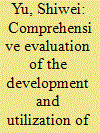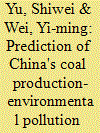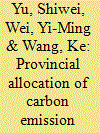|
|
|
Sort Order |
|
|
|
Items / Page
|
|
|
|
|
|
|
| Srl | Item |
| 1 |
ID:
166296


|
|
|
|
|
| Summary/Abstract |
This study proposes comprehensive evaluation criteria, involving aspects of energy, economy, environment, technology, and society (E3TS), for the development and utilization of renewable energy (RE). The criteria consist of 22 indicators. The comprehensive performance, from 2011 to 2015, of 30 provincial regions in China with respect to renewable energy development and utilization (REDU) was evaluated on the basis of the E3TS criteria, using an analytic network process (ANP). The results show that the total comprehensive performance (2011–2015) of all the 30 provincial regions of China improved in general. There was a marked improvement in technology performance. Qinghai, Yunnan, and Sichuan ranked the top three in comprehensive performance of REDU, while the comprehensive performance of Shaanxi, Hainan, and Henan were the lowest. During the study period, while the comprehensive performance of most provincial regions such as Ningxia and Xinjiang increased, that of five provincial regions, including Tianjin and Hainan, decreased. The regional comprehensive performance was severely affected by the installed capacity and power generation of RE.
|
|
|
|
|
|
|
|
|
|
|
|
|
|
|
|
| 2 |
ID:
150439


|
|
|
|
|
| Summary/Abstract |
Designing a desirable increasing block tariff for the residential gas retail market has been a challenging task for regulated utilities, especially in China. To deal with such problems, in this paper, we establish an agent-based, computational economics system to provide a formal evaluation of the direct and indirect influences of several issued increasing block tariffs in the residential gas market. Moreover, a comprehensive demand response behaviour model has been improved in term of price elasticity, while still coping with income levels and complex social environment. We also compute and compare the outcomes of several increasing block tariffs with the initial flat tariff by running the system on a test-case using real-world data from a middle-scale gas retail market in Wuhan. The results indicate that there is an appropriate increasing block gas tariff scheme that has greater ability to improve social equity while still ensuring operator revenue and promoting gas conservation. In order to offset the limitations of the proposed increasing block tariffs, the regulator should adopt some complementary measures, such as applying appropriate policies targeting the intended consumers, and allowing large families to obtain extra allowance of volume.
|
|
|
|
|
|
|
|
|
|
|
|
|
|
|
|
| 3 |
ID:
191281


|
|
|
|
|
| Summary/Abstract |
Given China's severely separated renewable energy (RE) supply area and load area, the power transmission capacity across regions restricts RE penetration and is directly affected by RE-related support policies. Thus, a multi-objective optimization model is developed to explore the impacts of changes in renewable portfolio standard (RPS) and feed-in tariff (FIT) policies on the optimal transmission line layout. The model regards the maximization of RE power grid-on and minimization of the total cost for the optimal line layout, transmission capacity, and technology selection. We found that power transmission in "West-to-East" and "North-to-South" is strengthened, with the capacity expected to expand 2.2 times between 2020 and 2040. 2024–2026 is the period with the most new lines. The new line grows when the RPS target increase. Compared with the business-as-usual scenario, in the two scenarios where RPS increased by 10% and 15%, the newly built lines' number could grow by 35% and 21%, respectively. On the contrary, if the FIT subsidy continues beyond 2020, the demand for new line construction may decrease, reducing 480 TWh (FIT2025) and 330 TWh (FIT2040) of RE power on-grid. Further, the penetration proportion of renewable generation could be 55.8%–61.8% in 2040, achieving high penetration of RE in China.
|
|
|
|
|
|
|
|
|
|
|
|
|
|
|
|
| 4 |
ID:
111444


|
|
|
|
|
| Publication |
2012.
|
| Summary/Abstract |
This paper proposes a hybrid model based on genetic algorithm (GA) and system dynamics (SD) for coal production-environmental pollution load in China. GA has been utilized in the optimization of the parameters of the SD model to reduce implementation subjectivity. The chain of "Economic development-coal demand-coal production-environmental pollution load" of China in 2030 was predicted, and scenarios were analyzed. Results show that: (1) GA performs well in optimizing the parameters of the SD model objectively and in simulating the historical data; (2) The demand for coal energy continuously increases, although the coal intensity has actually decreased because of China's persistent economic development. Furthermore, instead of reaching a turning point by 2030, the environmental pollution load continuously increases each year even under the scenario where coal intensity decreased by 20% and investment in pollution abatement increased by 20%; (3) For abating the amount of "three types of wastes", reducing the coal intensity is more effective than reducing the polluted production per tonne of coal and increasing investment in pollution control.
|
|
|
|
|
|
|
|
|
|
|
|
|
|
|
|
| 5 |
ID:
128047


|
|
|
|
|
| Publication |
2014.
|
| Summary/Abstract |
An approach to determine carbon emission reduction target allocation based on the particle swarm optimization (PSO) algorithm, fuzzy c-means (FCM) clustering algorithm, and Shapley decomposition (PSO-FCM-Shapley) is proposed in this study. The method decomposes total carbon emissions into an interaction result of four components (i.e., emissions from primary, secondary, and tertiary industries, and from residential areas) which composed totally by 13 macro influential factors according to the KAYA identity. Then, 30 provinces in China are clustered into four classes according to the influential factors via the PSO-FCM clustering method. The key factors that determine emission growth in the provinces representing each cluster are investigated by applying Shapley value decomposition. Finally, based on guaranteed survival emissions, the reduction burden is allocated by controlling the key factors that decelerate CO2 emission growth rate according to the present economic development level, energy endowments, living standards, and the emission intensity of each province. A case study of the allocation of CO2 intensity reduction targets in China by 2020 is then conducted via the proposed method. The per capita added value of the secondary industry is the primary factor for the increasing carbon emissions in provinces. Therefore, China should limit the growth rate of its secondary industry to mitigate emission growth. Provinces with high cardinality of emissions have to shoulder the largest reduction, whereas provinces with low emission intensity met the minimum requirements for emission in 2010. Fifteen provinces are expected to exceed the national average decrease rates from 2011 to 2020.
|
|
|
|
|
|
|
|
|
|
|
|
|
|
|
|
| 6 |
ID:
137693


|
|
|
|
|
| Summary/Abstract |
This study aims to estimate carbon intensity abatement potential in China at the regional level by proposing a particle swarm optimization–genetic algorithm (PSO–GA) multivariate environmental learning curve estimation method. The model uses two independent variables, namely, per capita gross domestic product (GDP) and the proportion of the tertiary industry in GDP, to construct carbon intensity learning curves (CILCs), i.e., CO2 emissions per unit of GDP, of 30 provinces in China. Instead of the traditional ordinary least squares (OLS) method, a PSO–GA intelligent optimization algorithm is used to optimize the coefficients of a learning curve. The carbon intensity abatement potentials of the 30 Chinese provinces are estimated via PSO–GA under the business-as-usual scenario. The estimation reveals the following results. (1) For most provinces, the abatement potentials from improving a unit of the proportion of the tertiary industry in GDP are higher than the potentials from raising a unit of per capita GDP. (2) The average potential of the 30 provinces in 2020 will be 37.6% based on the emission's level of 2005. The potentials of Jiangsu, Tianjin, Shandong, Beijing, and Heilongjiang are over 60%. Ningxia is the only province without intensity abatement potential. (3) The total carbon intensity in China weighted by the GDP shares of the 30 provinces will decline by 39.4% in 2020 compared with that in 2005. This intensity cannot achieve the 40%–45% carbon intensity reduction target set by the Chinese government. Additional mitigation policies should be developed to uncover the potentials of Ningxia and Inner Mongolia. In addition, the simulation accuracy of the CILCs optimized by PSO–GA is higher than that of the CILCs optimized by the traditional OLS method.
|
|
|
|
|
|
|
|
|
|
|
|
|
|
|
|
|
|
|
|
|